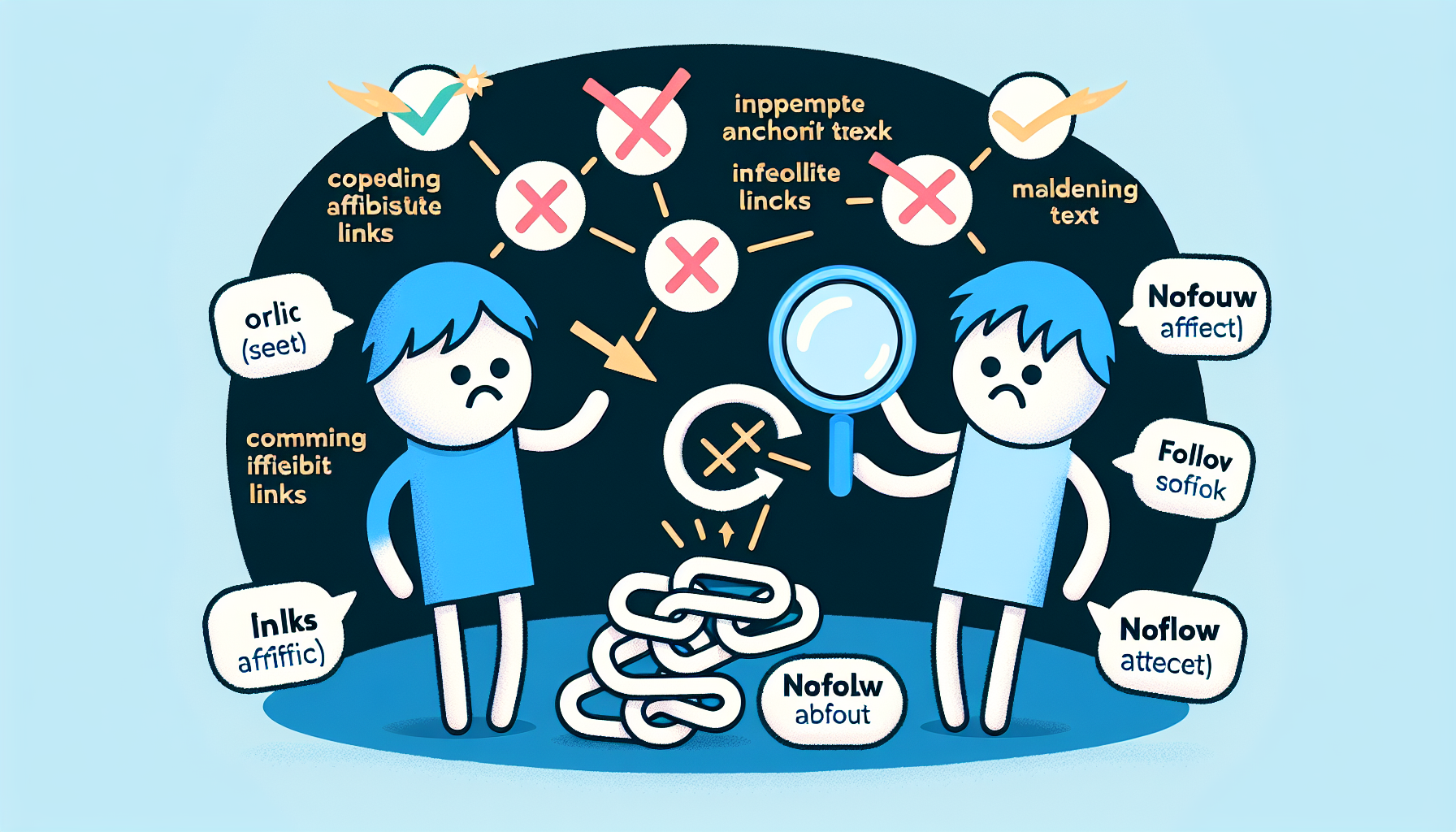Maximize Your Earnings: The Ultimate Guide to Mastering Affiliate Links

This article is designed to unpack the essentials of leveraging affiliate links for enhancing your online revenue. It provides a straightforward, practical guide on constructing and employing these links effectively, aimed at optimizing your earnings through successful affiliate marketing strategies. Discover the critical components you need to know in order to boost your profits with an effective use of affiliate partnerships starting now.
Key Takeaways
- Affiliate links enable marketers to earn commissions by promoting products or services, using unique URLs to track sales and attributing them to the affiliate’s marketing efforts, which often involves cookies that track consumer behavior for a set time period.
- Effective affiliate marketing requires selecting the right affiliate programs, tailoring links to targeted campaigns, and placing affiliate links strategically to balance visibility and engagement without compromising content relevance or trustworthiness.
- Compliance with legal guidelines, such as the FTC’s disclosure requirements, is essential in affiliate marketing to maintain transparency with your audience, alongside using tools for tracking and analytics to optimize campaigns and improve performance.
Understanding Affiliate Links: The Basics

Unique URLs, commonly referred to as affiliate links, are vital components of the affiliate marketing ecosystem. They enable individuals or companies, regarded as affiliates or affiliate partners, to promote goods and services on behalf of vendors or creators by utilizing various affiliate networks. These specialized links are crucial for monitoring the flow of web traffic propelled by an affiliate’s promotional activities toward the vendor’s site to ensure proper attribution for sales.
Upon a customer completing a purchase through one of these unique URLs—the cornerstone in question—the involved affiliate partner earns a commission from said transaction which is accurately tracked using this distinct link configuration. This methodology typically relies upon tracking cookies that record customer activity from engagement with affiliated content all through making purchases. Thus ensuring appropriate credit is given to the initiating affiliate.
Decoding the Structure of an Affiliate Link
An affiliate link isn’t merely a simple web address. It serves as an influential tracking instrument that incorporates vital data. At its core, this type of link contains both a tracking ID and an affiliate ID – key elements that play a significant role in the processes of monitoring and attributing sales or conversions. Such links are often enhanced with extra parameters designed to assess marketing campaign efficacy through comprehensive performance evaluations.
These additional parameters within the URL, typically marked by a question mark, are crucial for guaranteeing that any successful conversion is accurately associated with the appropriate publisher.
The Journey of an Affiliate Click
When a consumer embarks on the path of an affiliate click, it starts with their engagement on an affiliate link that navigates them to the website of a merchant. Subsequently, a cookie is deployed onto the user’s device which monitors their activity on the merchant’s platform over an established duration, Varying between 30 and 90 days.
Should this consumer finalize a purchase within this defined tracking window, the transaction gets logged by the affiliate network. This action credits the sale back to the responsible affiliate and consequently generates earnings for that affiliate marketer through commission.
Crafting Your Own Affiliate Links

The process of generating your own affiliate links is a vital component for success in the world of affiliate marketing. When you are setting up these links, you will typically need to:
- Use an affiliate dashboard to produce unique affiliate links
- Tailor URLs and strategize on how best to promote them
- Employ software from the affiliate program that allows for versatile creation of links
- Maintain consistency and control over the parameters within your affiliate link setup
- Streamline management processes while optimizing customization options during the creation of effective affiliate links.
Taking advantage of features such as linking coupons directly with specific URLs, designing more memorable and simpler web addresses, as well as adding custom SubIDs that point towards particular landing pages, can significantly boost the performance potential of your unique affiliate link. After becoming successfully registered with a business’s program affiliates, they receive an informative email covering important aspects like access information relating to their individualized link and insight into using their affiliated portal for oversight regarding sales tracking along with commission calculations.
Selecting the Right Affiliate Program
Selecting an appropriate affiliate program is vital in the realm of affiliate marketing. Ensuring that the chosen programs resonate with your brand’s ethos and uphold a good reputation is essential. Affiliate managers can be pivotal by helping you find offers pertinent to your niche and guide you on crafting promotional strategies, underscoring the importance of support when picking a program. Look for niche-specific options boasting attractive commissions and a solid performance history. Launching an own affiliate program allows customization according to what suits your brand best.
When considering an affiliation with any such program, it’s beneficial to delve into data concerning average conversion rates as well as monthly earnings from high-performing affiliates to gauge potential income avenues. But financial gain shouldn’t overshadow trustworthiness — knowledge about every product linked through your promotions ensures credibility among your audience base.
Tailoring Links for Targeted Campaigns
To enhance the performance of affiliate links, it’s crucial to customize them for specific campaigns. This requires:
- Establishing a framework for the promotion which may involve creating links that lead to promotional discounts
- Selecting primary marketing channels with care
- Setting a fixed timeframe for each campaign
Adapting affiliate links according to different countries can elevate the user experience and help avoid missing out on potential international affiliate sales. Utilizing tools such as Amazon OneLink helps in guiding customers to their respective local storefronts, thereby increasing the effectiveness of affiliate links among global audiences.
Developing potent content strategies that truly engage your intended market and leveraging insights from influencers can bolster search engine optimization (SEO). Such an approach can significantly propel your campaign towards greater success.
Best Practices for Affiliate Link Placement
The positioning of links plays a significant role in the efficacy of your affiliate marketing endeavors. It’s essential to strike the right balance with link placement within affiliate marketing to maintain prominence without giving off an excessive promotional vibe. How you position your affiliate links can influence the click-through rate by affecting both visibility and user interaction. For example, front-loading a piece might overwhelm readers with too many links, potentially making it seem spammy and not credible.
Here are some tactics that could be beneficial for deploying affiliate links:
- Place these crucial links on pages that already draw substantial traffic, then actively promote those particular pages to boost clicks which may lead to increased sales from affiliates.
- Integrate such web-links into dynamic or rich media content like videos, images or engaging quizzes as this tends to foster engagement and can encourage more conversions.
- The pertinence of any given link is paramount—the likelihood of obtaining clicks increases when there’s a strong relevance between the link itself, its context, and how it addresses a problem or need.
Adopting these approaches helps refine your strategies around affiliation promotion leading to better performance outcomes in terms of garnering success through effective marketing efforts using affiliations.
Balancing Content and Commerce
Striking the right balance between offering content and driving commerce is a nuanced undertaking. Prioritizing monetization at the expense of creating valuable content can detract from user experience, diminish trust, and lower the quality of your offerings. Thus, it’s vital to establish a well-defined niche or cultivate a personal brand that appeals to particular consumers who are more likely to respond positively to promotional activities.
When developing and overseeing content, knowing your audience inside out is critical. This knowledge allows for tailoring material that remains relevant and maintains high levels of engagement with those who consume it.
Integration with Social Media Platforms

Affiliate marketing has found a significant ally in social media platforms, enhancing its effectiveness. By skillfully combining social media with affiliate links, the reach of these links is broadened to various audience segments. The nature of social media facilitates rapid sharing and propagation of affiliate offers and products, which proves advantageous for time-sensitive campaigns. Notable among such platforms that are conducive to spreading affiliate content are Facebook, Instagram, Twitter, Pinterest, and YouTube.
Leveraging these networks can broaden your reach exponentially and contribute greatly to the success rate of your affiliate efforts.
It’s crucial to observe proper conduct when inserting affiliate links into your posts on social media by including disclosures like #ad as per FTC guidelines. This practice promotes honesty with your followers regarding endorsements or promotions you share.
The Legalities of Affiliate Links
As an affiliate marketer, it’s imperative not only to focus on product promotion and commission earning, but also to comply with legal standards. The Federal Trade Commission mandates that affiliates transparently disclose any relationship they have with merchants whose products or services they endorse. According to FTC guidelines, if you’re engaged in affiliate marketing, it is your duty to make known your affiliation with the advertised product or service.
Disclosure of any affiliations must be clear whenever a link could potentially yield a commission for the affiliate marketer. It’s vital for maintaining credibility among consumers by being open about such associations. This transparency underpins trust, which is foundational in effective affiliate marketing strategies. Affiliates should routinely indicate their links as such and provide access to an extensive disclosure document detailing Information about their ties and methods within the realm of affiliate practices.
Crafting Compliant Disclosures
Ensuring that disclosures in affiliate marketing are crafted to be compliant is essential. It’s important for these disclosures to stand out, being noticeable and the foremost element seen by viewers. They shouldn’t be obscured or diminished. Positioning the disclosures before any affiliate links is vital, as it communicates the nature of the affiliate relationship directly to consumers without necessitating additional clicks for more information.
Steer clear of vague references like (Affiliate) or #Affiliate on their own because they can lead to confusion among some users and fail to meet FTC standards regarding unambiguous disclosure. The right kind of disclosure will clearly inform potential customers about an affiliate’s commercial ties with a promoted entity and explicitly mention that purchases made may result in commission earnings for the affiliate.
Navigating International Disclosure Standards
When targeting a global audience, it’s vital to grasp the international standards for disclosure. Each country has different requirements and as an affiliate marketer, compliance with regional regulations is mandatory. For example:
- In the United Kingdom, the ASA requires that content related to affiliates be distinctly marked.
- Canada’s advertising code demands clear revelation of material relationships.
- The Australian ACCC requires influencers and affiliates to make their commercial partnerships transparent.
To achieve effective worldwide disclosures in affiliate marketing, they should meet several criteria.
- They need to be straightforward.
- Visibility must be ensured – they cannot go unnoticed.
- Disclosures must communicate in the language understood by your intended market audience
–Assumptions about an audience’s familiarity with affiliate marketing practices should not drive how information is presented.
Enhancing Performance with Affiliate Marketing Tools

Affiliate marketing tools can greatly enhance performance by making tasks more efficient and easier to manage. Advanced link management tools like Pretty Links, combined with affiliate tracking software, provide affiliates with more control and transparency over their affiliate campaigns, allowing for customized and integrated approaches to campaign setup. These tools also support scalability and optimization of affiliate programs by minimizing manual tracking errors and streamlining management.
Regularly reviewing and updating affiliate marketing strategies with tools that provide detailed performance reports enables affiliates to make data-driven decisions and optimize campaigns. Some best practices to consider include:
- A/B testing links and banners
- Analyzing user behavior and interactions using Artificial Intelligence (AI)
- Personalizing multimedia content and placement of affiliate links
By implementing these strategies, affiliates can improve the effectiveness of their marketing efforts.
Tracking and Analytics Platforms
The importance of tracking and analytics platforms in enhancing affiliate marketing campaigns cannot be overstated. Such tools are indispensable for publishers, ensuring they receive appropriate compensation for their promotional work while also providing data-driven insights that can improve strategies to boost revenue. Mastering link management is a key aspect for affiliates. It enables them to monitor the effectiveness of each link, pinpoint which URLs bring success, and improve those that fall short.
In the search for effective affiliate tracking software solutions, certain functionalities are essential.
- Effective sales tracking capabilities
- Accurate commission calculation systems
- Comprehensive performance reporting options
- Compatibility with existing technology infrastructures
A host of platforms like Voluum, Binom, BeMob, and RedTrack offer extensive metrics suitable for detailed analyses along with expedited report generation as well as sophisticated traffic distribution features and mechanisms to detect fraudulent activities—all designed to amplify your affiliate initiatives. Available are cloud-based utilities such as ThriveTracker and AdsBridge or self-hosted options including FunnelFlux. These provide a range tailored specifically towards helping affiliates through advantages like superior redirect speeds and intuitive visual funnel creation interfaces.
Link Management Solutions
Managing links effectively is essential for optimizing link personalization, orderly arrangement, and the ability to track their performance. Link management solutions like ThirstyAffiliates offer a range of functionalities including:
- Concealing affiliate links (link cloaking) and tailoring URLs which enhances their reliability as well as simplifying tracking processes
- Running checks for 404 errors to ensure all managed links are functional
- Facilitating automatic association of keywords with specific links
- Providing intuitive interfaces that simplify the organizational aspect of link handling
These capabilities not only streamline the customization and structuring process, but also bolster user experiences while streamlining oversight over traditional marketing efforts.
For affiliates engaged in various campaigns, it’s possible to select from multiple styles of hyperlinks such as redirect or direct options while leveraging techniques like domain redirections. This creates straightforward and memorable URL structures tailored specifically for an array of marketing initiatives. Automated systems designed for tracking affiliates enhance these programs by reducing manual error potentialities during monitoring activities thereby aiding program expansion and its refinement process.
Optimizing SEO with Affiliate Links
In the realm of affiliate marketing, mastering Search Engine Optimization (SEO) is paramount. By harnessing SEO effectively, one can attain a steady influx of passive traffic from searches and enhance engagements with affiliate links. If key SEO components such as title tags and meta descriptions are overlooked, there may be a marked decrease in how visible your content is within search engine results—this could significantly diminish the potential for traffic to your affiliate links. Optimizing content for mobile accessibility has become increasingly important due to the surge in mobile usage and Google’s punitive actions against sites that aren’t mobile-friendly, which can affect both user experience and positioning in search rankings.
Affiliate links play an essential role in bolstering SEO by creating backlinks to an affiliate’s site. These serve as indicators of its pertinence to search engines, which may lead to an uptick in search-sourced web traffic. Henceforth, deploying SEO tactics skillfully stands at the forefront of unlocking the full possibilities presented by your network of affiliate connections.
Do’s and Don’ts for SEO-friendly Affiliate Links

In order to optimize affiliate links for search engines, it is important to adhere to a set of guidelines. These include:
- Implementing nofollow tags on affiliate links in accordance with Google Webmaster Guidelines, which serves to prevent these links from influencing search engine rankings.
- Using a variety of anchor texts including branded terms, exact matches, and partial matches. This strategy promotes the creation of a link profile that appears organic and is preferred by search engines.
- Refraining from an over-reliance on exact match anchor text as doing so can be considered over-optimization by search engines and harm SEO efforts.
The content surrounding an affiliate link’s anchor text also plays a crucial role by providing context. This helps search engines discern the relevance of the link while also enhancing SEO for the linked pages.
Leveraging Influencer Marketing Campaigns
Collaborating with influencers who possess a robust online following is an effective method for amplifying traffic and enhancing visibility. Engaging in influencer marketing campaigns can result in elevated search engine placement, bolstered click-through rates, and the generation of fresh leads due to their extensive reach.
To achieve better SEO standings through affiliate marketing efforts, it’s essential that content crafted by these influencers encourages prolonged site engagement and upgrades the user experience. For successful outcomes in such campaigns, it’s crucial that there’s alignment between the influencer’s audience profile and ethical values with the specific niche and principles of your brand.
Monetization Strategies Beyond Basic Links
Affiliate marketing offers a variety of monetization strategies beyond basic links. High-ticket affiliate marketing involves promoting products or services with large payouts, which can result in substantial revenue from fewer conversions. Commissions in high-ticket affiliate marketing can range from $500 to $1,000 or even higher, offering a lucrative opportunity for marketers.
To succeed in high-ticket affiliate marketing, a strategic approach is necessary. Here are some key steps to follow.
- Choose a profitable niche.
- Connect with reputable affiliate programs.
- Establish an SEO-optimized online presence.
- Create evergreen content that provides long-term value and aligns with consistent search queries.
By following these steps, you can increase your chances of success in high-ticket affiliate marketing.
Tailoring affiliate products to match audience preferences and interests can significantly boost revenue by catering to what the audience is most likely to buy.
Exploring Different Types of Affiliate Partnerships
Affiliate partnerships come in three distinct forms: unattached, related, and involved affiliate marketing. These types signify varying degrees of connection and commitment to the promoted product. The commission rates within affiliate marketing are quite broad. They can start from 5% and reach up to 50% for higher-tier programs, while others might offer a set amount per transaction.
High-ticket items in the realm of affiliate marketing bring forth advantages including more substantial commissions, enhanced effectiveness of marketing efforts, solid brand collaborations, improved profit margins, and sustained longevity. For high-ticket offers to succeed in affiliate marketing endeavors, it requires employing an array of strategies like producing content material, crafting reviews or testimonials.
leveraging social media drives alongside email campaigns as well as paid advertising initiatives— all these supported by tools that monitor advertisements performance and manage payouts with comprehensive managerial backing provided by the respective platform.
Innovative Uses of Affiliate Links
Creativity plays a crucial role in the realm of affiliate marketing. Incorporating engaging multimedia content such as videos and podcasts adorned with affiliate links can captivate audiences and improve click-through rates. The power of visual storytelling, utilizing elements like images, infographics, animated videos, comics, and illustrations integrated with affiliate links, has the potential to strike a chord with viewers and motivate them to take action.
The addition of interactive features—for instance, clickable annotations within videos or embedded hyperlinks in infographics—can greatly elevate both the engagement levels and interactivity associated with affiliate promotions. Establishing well-considered alliances aimed at promoting specialized items tailored for an affiliate’s audience can optimize both relevance and effectiveness when it comes to utilizing those all-important affiliate links.
Affiliate Link Mistakes to Avoid
Affiliate marketing presents opportunities for significant income, but it also comes with its set of challenges. One key to success is steering clear of errors such as endorsing offers that don’t align with your audience’s interests. This can diminish conversion rates and harm your credibility as a reliable information source. Crowding a webpage with excessive affiliate links may overwhelm visitors and negatively affect the user experience.
Inserting affiliate links without considering how they fit into content can alienate readers, leading to decreased engagement. To ensure effective use of affiliate links while maintaining reader trust, be cautious not to include:
- Links that are non-functional or broken which might deter users who were ready to engage in purchasing.
- Concealed or deceptive links could be seen as dishonesty causing loss of confidence from your audience and invite legal action against you.
- Failing transparency about being an affiliate risks legal issues and undermines building trust among followers.
By sidestepping these errors, you maintain the integrity of your relationship with your audience while leveraging affiliates’ benefits.
Overlooking the Importance of Relevance
In the realm of affiliate marketing, disregarding relevance is a critical blunder to avoid. Relevance plays an essential role in this industry as it has a considerable influence on conversion rates and, subsequently, commissions earned. Frequently, affiliate marketers falter by failing to tailor their content to resonate with their audience’s preferences and requirements. This misstep can result in recommending products that lack relevance, leading to dwindling conversions.
Thus, it’s imperative for affiliates to guarantee that the products they are promoting correspond well with their target audience’s interests and needs. Being relevant means bridging the gap between suitable products and interested consumers effectively boosting performance metrics within the sphere of affiliate marketing.
Ignoring the User Experience
In the realm of affiliate marketing, overlooking the user experience is a widespread misstep. Ensuring that users can navigate effortlessly is essential. This means employing clear design principles such as incorporating a home button into the brand logo, utilizing distinct headings, and implementing breadcrumb trails to bolster navigation efficiency. When main categories are prominently displayed on the homepage, it gives visitors an immediate understanding of what’s available on the site and how they might benefit from products—this attention to detail enriches their overall experience.
On another note, forceful selling techniques like obtrusive banner ads and pop-up windows tend to annoy users and may lead them to exit rapidly from your page – thus raising bounce rates. By interspersing more white space around elements within an affiliate website, you provide space for critical information to stand out, which in turn enhances content legibility. When crafting anchor text for affiliate links, it’s crucial these texts are succinct, pertinent, without keyword stuffing – aligning with SEO best practices while simultaneously improving user interactions on-site.
Summary
To summarize, the essence of affiliate marketing lies in effectively managing your affiliate links. It’s essential to comprehend how an affiliate clicks, devise unique affiliate links with precision, choose fitting affiliate programs and customize these links for specific campaigns meticulously. Integrating link placement best practices along with compliance to legal standards, employing adept use of various tools tailored for affiliates, enhancing SEO tactics, investigating different monetization avenues, as well as creative applications of such links are all integral parts leading to a triumphant tenure in this domain. Bypassing pitfalls like disregarding link relevance or neglecting the user’s experience can significantly smooth out your path in this realm. Affiliate marketing isn’t simply about earning quickly, but revolves around nurturing trustworthiness, adding real value and forging a long-lasting source of revenue.
Frequently Asked Questions
How do I get an affiliate link?
To begin earning through an affiliate program, you must first select a product you wish to endorse. After verifying that the chosen product offers an affiliate program, sign up for it. Subsequently, you’ll receive your unique affiliate link which allows you to start generating income whenever visitors click on this link.
Do affiliate links actually make money?
Certainly, affiliate links have the potential to generate substantial revenue, as evidenced by top affiliates earning in excess of $100,000 monthly. Nevertheless, this requires commitment and selecting a niche that truly piques your interest.
Can you make $10000 a month with affiliate marketing?
Indeed, by employing an effective strategy and consistently monitoring and tweaking your results, you have the potential to earn $10,000 monthly or even more via affiliate marketing.
How much do affiliate links pay?
The earnings from affiliate links can range vastly, offering anywhere between a 5% to 50% commission on sales or sometimes providing a fixed amount for each sale. While most affiliates make an annual income ranging from nothing to $80,000, there is a lesser proportion of them who earn significantly more—between $80,001 and as much as $1 million per annum.
What is an affiliate link and how does it work?
A unique URL, known as an affiliate link, monitors the flow of customers from an affiliate’s promotional efforts to a merchant’s site and credits transactions accordingly. When a sale is made through this link, the affiliate earns a commission.


